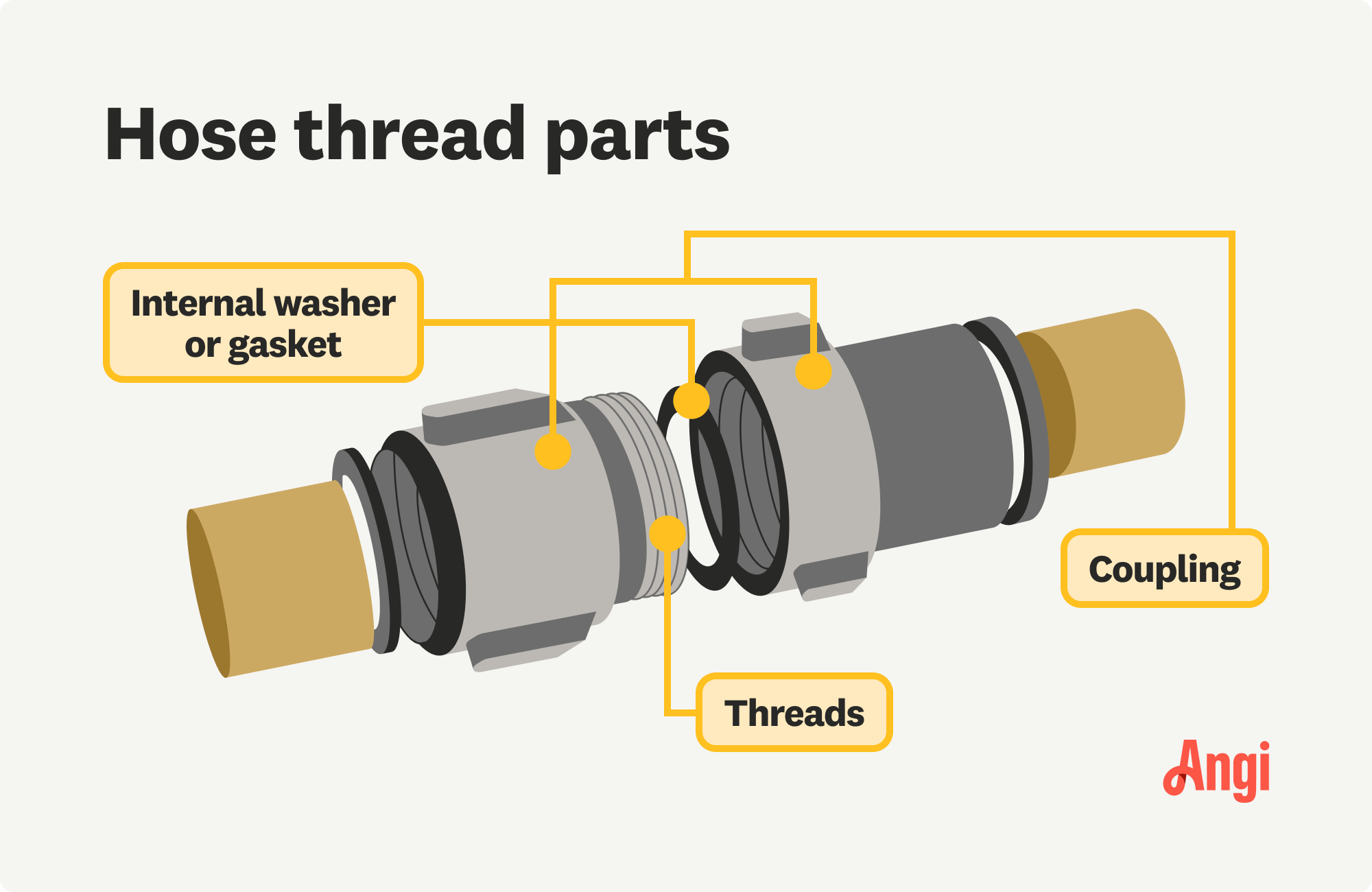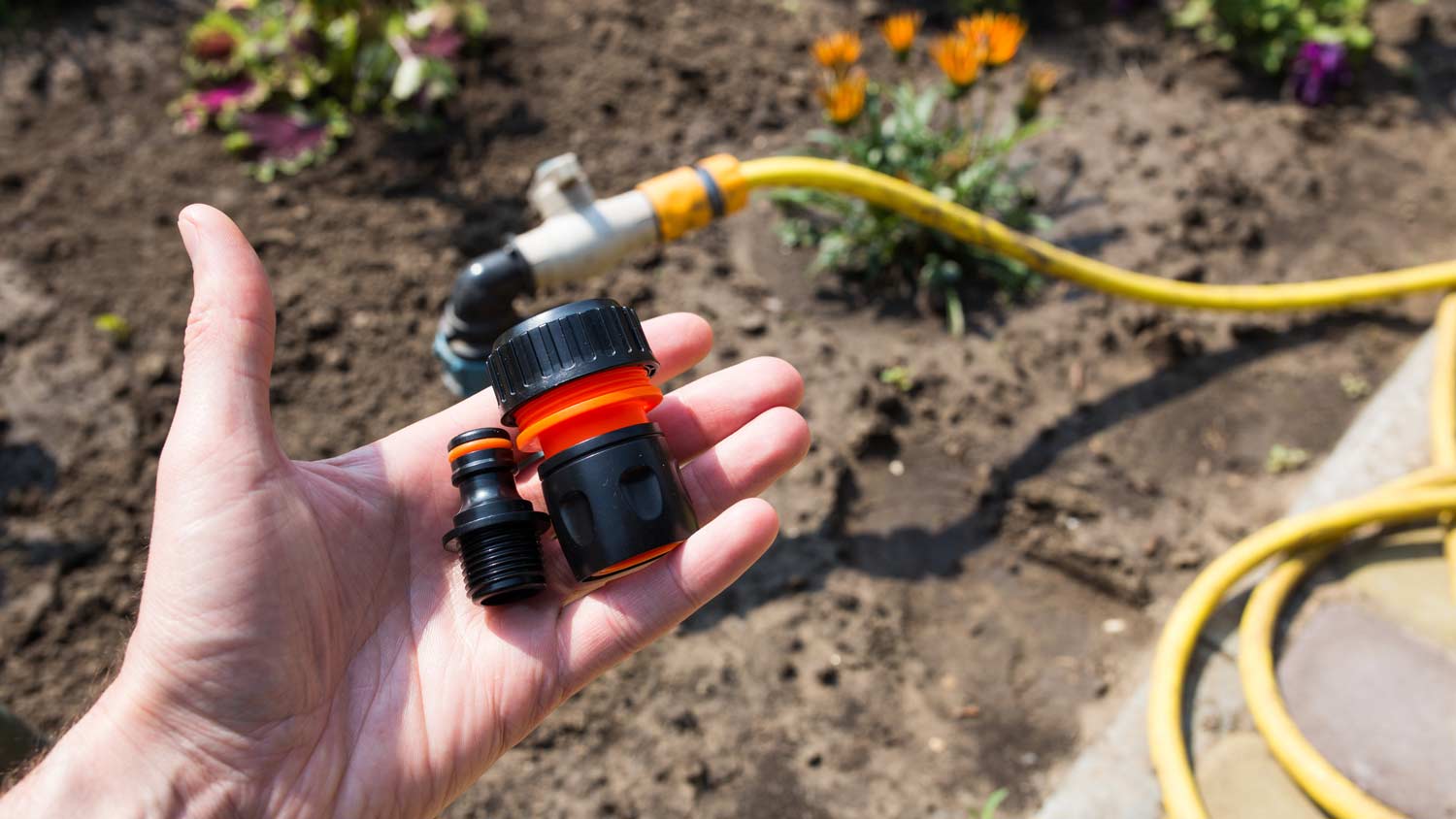
Discover drip irrigation system cost estimates, key price factors, and ways to save. Get transparent pricing to plan your home irrigation project confidently.
Get connected with the right garden hose fittings


Garden hose fittings let you easily attach to water sources and accessories.
Fittings are individual components, while couplings are a pair of fittings.
The most common fitting size is 3/4 inch, but 5/8 and 1/2 inch are popular.
Hose coupling threads fit tightly together to attach equipment without leaks.
Your fittings must be the correct size to fit together correctly.
Garden hose fittings, or couplings or adaptors, make it easier and faster to attach sprayers, sprinklers, and other attachments to garden hoses and attach hoses to a water source. The right fittings will let you seamlessly connect your hose without leaks, but the wrong size fitting makes it hard to switch equipment without chaotic leaks from the fitting connections. Here’s how to tell your garden hose thread size and choose the right size fitting for your needs.
When taking on this project, expect questions only a pro can answer. With our network of local pros, you'll get the job done and your questions answered—without the hassle and stress of doing it yourself.
While you can get garden hose fittings in a variety of sizes, you’ll find that there are three most common sizes:
3/4 inch
5/8 inch
1/2 inch
Standard garden hoses come with 3/4-inch fittings, so this is most likely what your hose came with. Since it’s a bigger opening, it allows more water flow and pressure for tasks that require more water, like watering a garden and washing your car. Garden hose fittings measuring 5/8 inch are a bit smaller, and 1/2-inch hose fittings are even smaller. The latter works best for smaller watering tasks that require less water flow or pressure, such as drip irrigation systems.
Specialized fittings like 1-inch or 3/8-inch fittings for specialty equipment or industrial-grade hoses are rare and harder to find.
Garden hose threads are the raised lines on hose fittings that allow the hose and attachments to fit together tightly so the two sides can seal around the internal washer or gasket and prevent leaks, like a kitchen faucet. Most hose fittings are made of metal (brass, aluminum, or steel) or heavy-duty plastic. The inside diameter of the threaded fittings is known as the thread size, which matters when connecting two fittings or a coupling together.

In the United States, thread sizes are measured in Garden Hose Threads (GHT) and National Pipe Taper (NPT) threads. Most garden hoses and accessories use the GHT standard measurement, which is determined by the inside diameter of the fitting and the threads per inch. Hoses and couplers that meet these standards will thread together correctly.
You’ll see references to male and female connections when shopping for a replacement fitting. Once you understand the differences, it’s pretty easy to identify one versus the other.
Male couplings have threads on the outside of the attachment, while female fittings have threads on the inside. The male fitting fits inside the female fitting when the two are put together. You must have one male and one female fitting for a coupling to fit together.

Depending on how you use your garden hose, you can choose among several hose fittings. Here are some of the most popular options:
Standard: Standard hose connectors link two hoses together to extend the reach of your hose. Most standard fittings have a female and male end with simple threads.
Threaded: Threaded connectors, like GHT or NPT, are frequently used to connect hoses with water spigots or hose bibs and accessories, including sprinklers and drip irrigation systems.
Quick Connect: These fittings allow users to connect and disconnect hoses from accessories like handheld sprayers. Most quick-connect fittings have male and female connections that snap or click together without threading or tightening the fittings.
Spray Nozzle: Spray nozzle fittings attach to garden hoses and are used for watering gardens and washing cars or windows. They have adjustable spray patterns that you can change with the click of a dial and easily thread or quick-connect to hoses.
Y-Connectors: A Y-connector allows you to split a single water source into two hoses, Either at the hose bib or the end of a hose. The connector has a Y-shape that branches off in two directions, allowing users to attach two separate hoses to the same source.
Hose Menders: If you have a hose mender, you don’t need to throw away damaged or leaking hoses. These plastic or metal hose clamps can stop leaks and cover gashes.
Shutoff Valves: If your water source is far from where you’re watering, a shutoff valve fitting can save you some steps. These fittings let you turn off the water at the sprayer end of the hose, so you don’t have to walk all the way back to the spigot.
You need the right-sized garden hose fittings so your hose will fit properly with water sources and attachments. That means you’ll need to know the size of the hose fitting and the connecting fitting you’re attaching to.
It’s hard to measure fittings and threads, so most garden hoses have packaging labels or markings on the hoses themselves that indicate the size of the inner diameter of the hose. Choose replacement fittings and accessories with the same size.
Garden hose couplings are almost always measured based on the interior diameter of the fitting. Fittings need to fit over the outer diameter of the hose so they can seal properly.

If you’re having problems and wondering why your garden hose is leaking, the wrong size garden hose fitting or a damaged fitting can be to blame, among other reasons. Garden hose sizing matters, so know the size of your garden hose and your garden hose fitting size when shopping for new fittings, equipment, and accessories.
You can also contact a sprinkler installer near you for advice. They can help you set up your garden hoses with the correct fittings for your spigot and accessories.
Most garden hoses come with secure fittings at either end of the hose, including one male and one female fitting that allow you to connect one end of the hose to a water source and the other end to a sprinkler, sprayer nozzle, another hose, or other attachments. If you purchase a standard hose, standard accessories, and standard replacement fittings, your hose should easily connect to them.
To install garden hose fittings, connect the female fitting to the male fitting and turn clockwise until it’s tight. Garden hose fittings thread tightly together and eliminate leaks by squeezing a washer or gasket, so be sure your couplers thread smoothly together. If your couplings are small or octagon-shaped, you can use a wrench to tighten them. It’s important to tighten couplers firmly but not too tightly to get a good seal without damaging the leak-preventing washer or gasket.
Add thread seal or plumber’s tape to the connecting threads to make your fittings even more watertight. It’s smart to do this between a water source and a hose you plan to leave in place for the entire gardening season.
If you have incorrectly sized fittings, or if your hose, water source, or equipment are different sizes, you can buy adapters and couplers that connect nearly any size hose with nearly any spigot or accessory.
Alternatively, if you have the wrong fitting size or a hose with fittings that don’t match your water source or gardening equipment, simply buy a new hose or a replacement fitting that is the correct size. That can save you frustration and wasted water, and it can make connecting your hose with water sources or accessories easier.
From average costs to expert advice, get all the answers you need to get your job done.

Discover drip irrigation system cost estimates, key price factors, and ways to save. Get transparent pricing to plan your home irrigation project confidently.

If your sprinkler system isn’t working, it may be time for a new pump. Find out sprinkler pump replacement costs with this guide.

A French drain costs around $9,250 to install, but several factors will determine the final price you pay. Learn the cost to install French drains in this guide.

Learning how to convert your sprinkler to drip irrigation saves you money on water use and reduces weed growth. Follow this guide to learn how to do it.

Drip irrigation vs. soaker hose: Which should a gardener choose? Here’s how to tell which of these watering options will work best for your landscaping needs.

Sprinkler systems offer lots of variety in sprinkler heads. Learn the differences between sprinkler head types to find the best one for your watering needs.